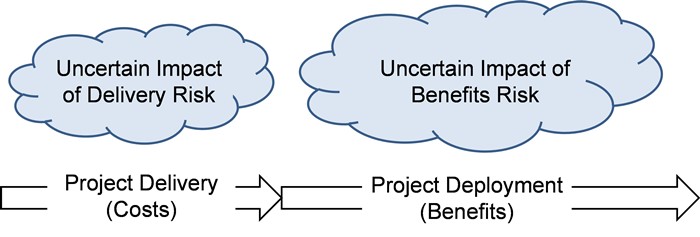A brief guide
Practical Project Risk Management
SERIES ARTICLE
By Martin Hopkinson
United Kingdom
Purposes
- Manage the risk to project benefits from the earliest opportunity.
- Optimize the trade-off between risk to a project’s delivery and risk to its benefits.
The Risk to Project Benefits Usually Exceeds the Risk to Project Delivery
In a simple project lifecycle model, the benefits of a project start to be realized after the completion of project delivery as illustrated by the figure below.

Reasons why the risk to project benefits tends to exceed the risk to its delivery phase include:
- The value of project benefits exceeds the sum of the project’s delivery cost and any subsequent through life costs (assuming there is a positive business case).
- Benefits materialize during a later period, which can make the consequences of the associated risk more uncertain.
- Adverse consequences of project ownership (disbenefits) are often unidentified.
Despite the risk to project benefits, many organizations focus primarily on project delivery risk. In doing so, they often fail to manage the larger part of the project’s risk exposure.
Project Benefits that may be important to the Business Case
Project benefits may include those with economic and/or noneconomic value including:
- Value to the owners and users of the project’s products.
- Operations efficiency savings.
- Increase in profit due to increased turnover and/or profitability.
- Release of assets for sale, scrap value, let or other beneficial purposes.
- Externally sourced financial benefits e.g. subsidies or tax breaks.
- Reputational benefits.
- Leverage of opportunities for future projects.
More…
To read entire article, click here
Editor’s note: This series of articles is by Martin Hopkinson, author of the books “The Project Risk Maturity Model” and “Net Present Value and Risk Modelling for Projects” and contributing author for Association for Project Management (APM) guides such as Directing Change and Sponsoring Change. These articles are based on a set of short risk management guides previously available on his company website, now retired. For an Introduction and context for this series, click here. Learn more about Martin Hopkinson in his author profile below.
How to cite this paper: Hopkinson, M. (2023). Risk to Project Benefits: A brief guide, Practical Project Risk Management series, PM World Journal, Vol. XII, Issue X, October. Available online at https://pmworldlibrary.net/wp-content/uploads/2023/10/pmwj134-Oct2023-Hopkinson-risk-to-project-benefits-series-article.pdf
About the Author

Martin Hopkinson
United Kingdom
![]()
Martin Hopkinson, recently retired as the Director of Risk Management Capability Limited in the UK, and has 30 years’ experience as a project manager and project risk management consultant. His experience has been gained across a wide variety of industries and engineering disciplines and includes multibillion-pound projects and programmes. He was the lead author on Tools and Techniques for the Association for Project Management’s (APM) guide to risk management (The PRAM Guide) and led the group that produced the APM guide Prioritising Project Risks.
Martin’s first book, The Project Risk Maturity Model, concerns the risk management process. His contributions to Association for Project Management (APM) guides such as Directing Change and Sponsoring Change reflect his belief in the importance of project governance and business case development.
In his second book Net Present Value and Risk Modelling for Projects he brought these subjects together by showing how NPV and risk modelling techniques can be used to optimise projects and support project approval decisions. (To learn more about the book, click here.)
To view other works by Martin Hopkinson, visit his author showcase in the PM World Library at https://pmworldlibrary.net/authors/martin-hopkinson/









